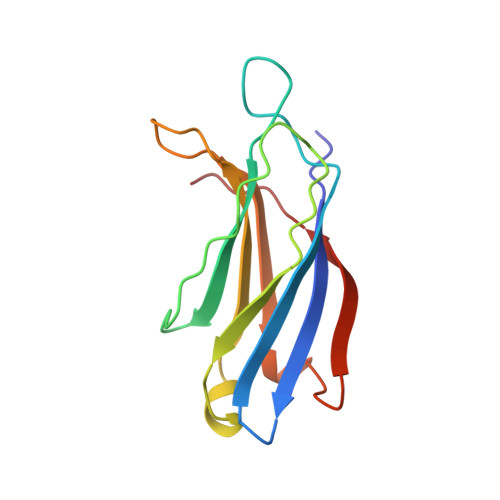Solution structures of the Ca2+-free and Ca2+-bound C2A domain of synaptotagmin I: does Ca2+ induce a conformational change?
Shao, X., Fernandez, I., Sudhof, T.C., Rizo, J.(1998) Biochemistry 37: 16106-16115
- PubMed: 9819203
- DOI: https://doi.org/10.1021/bi981789h
- Primary Citation of Related Structures:
1BYN - PubMed Abstract:
C2 domains are widespread Ca2+-binding modules that are particularly abundant in proteins involved in membrane traffic and signal transduction. The C2A domain of synaptotagmin I is believed to play a key role in neurotransmitter release through its Ca2+-dependent interactions with syntaxin and phospholipids. Elucidating the structural consequences of Ca2+ binding to the C2A domain is critical for understanding its mechanism of action and for models of the functions of other C2 domains. We have determined the solution structure of the Ca2+-free and Ca2+-bound forms of the C2A domain of synaptotagmin I by NMR spectroscopy. Our data represent the first structure determination of a C2 domain in its Ca2+-free and Ca2+-bound forms. Three Ca2+ ions were included in the Ca2+-bound structure, yielding a Ca2+-binding motif that involves five aspartate side chains and one serine side chain. Ca2+ immobilizes the structure of the C2A domain but does not produce a significant conformational change from a well-defined conformation to another. Thus, the mechanism of action of the C2A domain of synaptotagmin I is different from that used by Ca2+-binding proteins of the EF-hand family. The main effect of Ca2+ binding on the C2A domain is to change its electrostatic potential rather than its structure. These results support a model whereby the C2A domain functions as an electrostatic switch in neurotransmitter release. The similarity between the structures of the synaptotagmin I C2A domain and the PLC-delta1 C2 domain suggests that the latter binds four Ca2+ ions and acts by a similar mechanism. This mechanism may also be valid for other C2 domains that share the unusual ability to bind multiple Ca2+ ions in a tight cluster at the tip of the domain.
Organizational Affiliation:
Department of Biochemistry, University of Texas Southwestern Medical Center at Dallas 75235, USA.















